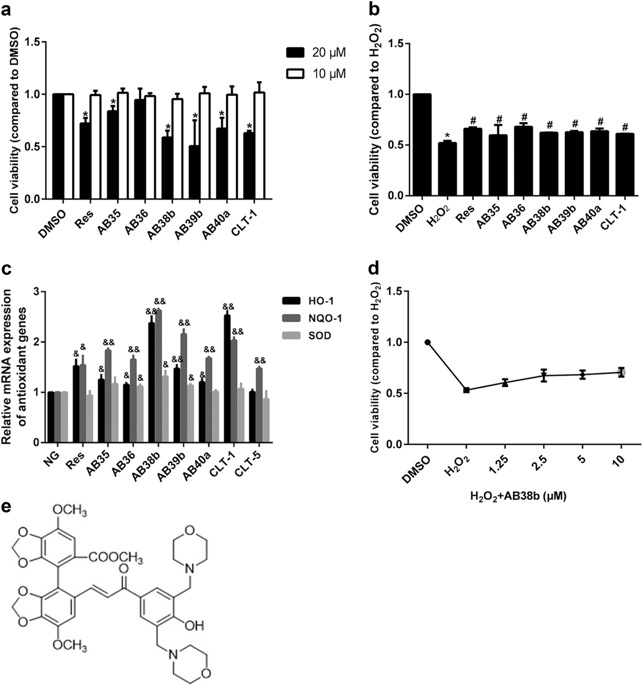当前位置:
X-MOL 学术
›
Acta Pharmacol. Sin.
›
论文详情
Our official English website, www.x-mol.net, welcomes your
feedback! (Note: you will need to create a separate account there.)
A novel compound AB38b attenuates oxidative stress and ECM protein accumulation in kidneys of diabetic mice through modulation of Keap1/Nrf2 signaling.
Acta Pharmacologica Sinica ( IF 6.9 ) Pub Date : 2019-10-23 , DOI: 10.1038/s41401-019-0297-6 Lei Du 1 , Lei Wang 1 , Bo Wang 1 , Jin Wang 1 , Meng Hao 1 , Yi-Bing Chen 1 , Xi-Zhi Li 1 , Yuan Li 1 , Yan-Fei Jiang 1 , Cheng-Cheng Li 1 , Hao Yang 1 , Xiao-Ke Gu 1 , Xiao-Xing Yin 1 , Qian Lu 1
Acta Pharmacologica Sinica ( IF 6.9 ) Pub Date : 2019-10-23 , DOI: 10.1038/s41401-019-0297-6 Lei Du 1 , Lei Wang 1 , Bo Wang 1 , Jin Wang 1 , Meng Hao 1 , Yi-Bing Chen 1 , Xi-Zhi Li 1 , Yuan Li 1 , Yan-Fei Jiang 1 , Cheng-Cheng Li 1 , Hao Yang 1 , Xiao-Ke Gu 1 , Xiao-Xing Yin 1 , Qian Lu 1
Affiliation

|
Extracellular matrix (ECM) deposition following reactive oxygen species (ROS) overproduction has a key role in diabetic nephropathy (DN), thus, antioxidant therapy is considered as a promising strategy for treating DN. Here, we investigated the therapeutic effects of AB38b, a novel synthetic α, β-unsaturated ketone compound, on the oxidative stress (OS) and ECM accumulation in type 2 diabetes mice, and tried to clarify the mechanisms underlying the effects in high glucose (HG, 30 mM)-treated mouse glomerular mesangial cells (GMCs). Type 2 diabetes model was established in mice with high-fat diet feeding combined with streptozocin intraperitoneal administration. The diabetic mice were then treated with AB38b (10, 20, 40 mg· kg-1· d-1, ig) or a positive control drug resveratrol (40 mg· kg-1· d-1, ig) for 8 weeks. We showed that administration of AB38b or resveratrol prevented the increases in malondialdehyde level, lactate dehydrogenase release, and laminin and type IV collagen deposition in the diabetic kidney. Simultaneously, AB38b or resveratrol markedly lowered the level of Keap1, accompanied by evident activation of Nrf2 signaling in the diabetic kidney. The underlying mechanisms of antioxidant effect of AB38b were explored in HG-treated mouse GMCs. AB38b (2.5-10 μM) or resveratrol (10 μM) significantly alleviated OS and ECM accumulation in HG-treated GMCs. Furthermore, AB38b or resveratrol treatment effectively activated Nrf2 signaling by inhibiting Keap1 expression without affecting the interaction between Keap1 and Nrf2. Besides, AB38b treatment effectively suppressed the ubiquitination of Nrf2. Taken together, this study demonstrates that AB38b ameliorates experimental DN through antioxidation and modulation of Keap1/Nrf2 signaling pathway.
中文翻译:

一种新型化合物AB38b通过调节Keap1 / Nrf2信号传导减弱了糖尿病小鼠肾脏中的氧化应激和ECM蛋白积累。
活性氧(ROS)过量产生后的细胞外基质(ECM)沉积在糖尿病性肾病(DN)中起关键作用,因此,抗氧化剂治疗被认为是治疗DN的一种有前途的策略。在这里,我们研究了新型合成的α,β-不饱和酮化合物AB38b对2型糖尿病小鼠的氧化应激(OS)和ECM蓄积的治疗作用,并试图阐明高血糖作用的潜在机制( HG,30 mM)处理的小鼠肾小球系膜细胞(GMC)。在高脂饮食喂养和腹膜内施用链佐星的小鼠中建立2型糖尿病模型。然后用AB38b(10、20、40 mg·kg-1·d-1,ig)或阳性对照药物白藜芦醇(40 mg·kg-1·d-1,ig)治疗糖尿病小鼠8周。我们显示,AB38b或白藜芦醇的给药可防止丙二醛水平,乳酸脱氢酶释放以及层粘连蛋白和IV型胶原在糖尿病肾中的沉积增加。同时,AB38b或白藜芦醇显着降低了Keap1的水平,并伴随着糖尿病肾脏中Nrf2信号的明显激活。在HG处理的小鼠GMC中探索了AB38b抗氧化作用的潜在机制。AB38b(2.5-10μM)或白藜芦醇(10μM)显着减轻了HG处理的GMC中的OS和ECM积累。此外,AB38b或白藜芦醇治疗可通过抑制Keap1表达而有效激活Nrf2信号传导,而不会影响Keap1与Nrf2之间的相互作用。此外,AB38b处理可有效抑制Nrf2的泛素化。在一起
更新日期:2019-10-24
中文翻译:

一种新型化合物AB38b通过调节Keap1 / Nrf2信号传导减弱了糖尿病小鼠肾脏中的氧化应激和ECM蛋白积累。
活性氧(ROS)过量产生后的细胞外基质(ECM)沉积在糖尿病性肾病(DN)中起关键作用,因此,抗氧化剂治疗被认为是治疗DN的一种有前途的策略。在这里,我们研究了新型合成的α,β-不饱和酮化合物AB38b对2型糖尿病小鼠的氧化应激(OS)和ECM蓄积的治疗作用,并试图阐明高血糖作用的潜在机制( HG,30 mM)处理的小鼠肾小球系膜细胞(GMC)。在高脂饮食喂养和腹膜内施用链佐星的小鼠中建立2型糖尿病模型。然后用AB38b(10、20、40 mg·kg-1·d-1,ig)或阳性对照药物白藜芦醇(40 mg·kg-1·d-1,ig)治疗糖尿病小鼠8周。我们显示,AB38b或白藜芦醇的给药可防止丙二醛水平,乳酸脱氢酶释放以及层粘连蛋白和IV型胶原在糖尿病肾中的沉积增加。同时,AB38b或白藜芦醇显着降低了Keap1的水平,并伴随着糖尿病肾脏中Nrf2信号的明显激活。在HG处理的小鼠GMC中探索了AB38b抗氧化作用的潜在机制。AB38b(2.5-10μM)或白藜芦醇(10μM)显着减轻了HG处理的GMC中的OS和ECM积累。此外,AB38b或白藜芦醇治疗可通过抑制Keap1表达而有效激活Nrf2信号传导,而不会影响Keap1与Nrf2之间的相互作用。此外,AB38b处理可有效抑制Nrf2的泛素化。在一起













































 京公网安备 11010802027423号
京公网安备 11010802027423号